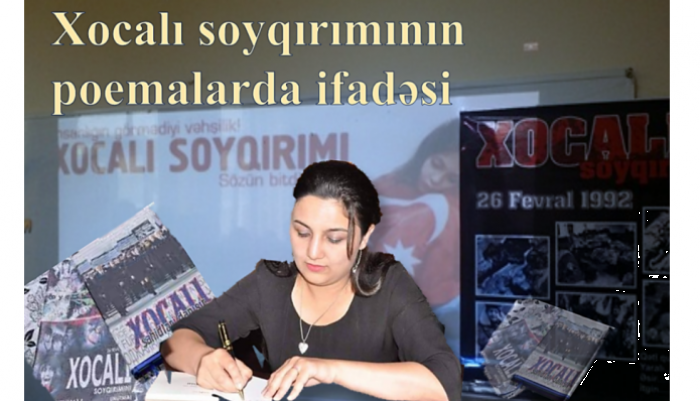
The genocide committed by Armenians against Azerbaijanis in Khojaly 31 years ago is one of the most frequently addressed topics in Azerbaijani poems written during independence. The artistic reflection of that genocide is "Tears of that girl" by Zalimkhan Yagub, "Khojali wants peace" by Farida Hijra, "I call for war" by Elbariz Mammadli, "Khojali khajilari" by Alakbar Salahzadeh, "My Khojali" by Adalat Askaroglu, "Martyr city" by Alamdar Guluzadeh, "Khojali Symphony" of Nurangiz Gün, etc. created in poems. In those works, the image of Chingiz Mustafayev and his services are in the center of attention. On the other hand, the similarity of fate of the cities of Khojaly-Khirosima-Khatin, whose first letters are the same, has been compared in most poems. Due to the time and place of the tragedy, the Khojaly genocide was presented as a tragic massacre.
These ideas are included in the article titled "Expression of the Khojaly Genocide in Poems" by Gulnar Sama, Doctor of Philosophy in Philology. We present the article.
Elbariz Mammadli's poem "I call for war" begins with the motives of protest against the division of the world map by the unjust. In Khojaly, anger was expressed that Armenians destroyed children whose bodies were frozen, bayoneted, and their foreheads were shaved in front of the eyes of the whole world. On a day when all sides were covered with snow, Moscow and Yerevan, who celebrated the blood shed, were sure that one day this blood would catch the executioners, and the belief was manifested in the poem. In the work, it is reflected that the root of that tragedy is the division of Azerbaijan into two, the relocation of Armenians to the historical lands of Azerbaijan.
Zalimkhan Yaqub's poem "Tears of that girl" written in 2005 summarizes the victims of the tragedy in the example of Khazangul, a real Azerbaijani child. With the description of his father Tawakkul, his mother Rayan, and his sister Yegana being mercilessly killed before his eyes, the poet revives the identity of the enemy. The "Tears of that girl" part of the poem is written with such sensitivity and heartburn that the reader must be influenced by those verses and experience the horrors of the Khojaly tragedy once again. After demonstrating Khazangul's inflexibility, the author created a picture of the wartime realities. He vividly described how the girl's father was tied to a tree and burned alive in front of his child. The girl, who couldn't bear her father's torture, lost consciousness, and when she opened her eyes, saw that there was no trace of her father, it was played out as a terrible scene. The Azerbaijani girl who was condemned to see these cruelties does not break, she gets stronger from her hatred of the enemy.
Nurangiz Gunun's "Khojali Symphony" requiem, which tells about that tragedy, was translated into English and Russian and published as a booklet in 2006. The work is written in a journalistic tone in the form of the author's rhetorical questions. The author used coded images in the poem.
In Alekbar Salahzade's poem "Khojali Khajilari", the silence of such a noise in Europe, Asia, America, and Africa is interpreted as "SOS" rather than "Silence" of the world. Chingiz Mustafayev's fruitless efforts, who wanted to shout this disaster to them, constitute the central line of the work. Chingiz's sobbing shock at the terrible fate of the cubs, who were silenced under blood-patterned ice blankets and called for their mother, is extremely effective in the work. Khojaly - Chingiz Mustafayev - Safir triangle is particularly noticeable in the poem. Khojaly is a victim of brutal injustice, Genghis wants to reveal this brutality, and Safir is a character who wants to cover it up.
Although Alamdar Guluzade's poem "Martyr City" was written in 1992-1994, it was published as a separate book in 1998. A part of the poem was given with the subtitle "366...". The essence of that number is conveyed by these verses: "366 - the one who grows tall with my bread is mean, the belly that fills with fat." In the "Ganchichayi" section of the work, real images of the tragedy were created. Armenian opportunism was demonstrated in the verses written in the "Prisoners, Hostages" chapter, "The hearts of those who do not sleep with their tongues tied, their kidneys abroad..." or "Slaughterhouses are waiting somewhere for the captured, not camps." Their brutal use of the body of a Turkish person for profit has been raised. The author, shaken by the calamity of his people, wrote with inner anguish that his father was also a victim of Armenian vandalism on that day. It was not possible to bury his old father's body for days. The lines "We were able to lay my father to rest one day before Novruz holiday" show what tragedies the period between February 26 and March 21 witnessed. In the "Chingiz Mustafayev", "Talatum", "Khatin-Khirosima-Khojaly road" sections of the poem, the cunning and ruthlessness of the enemy is described in all its nakedness.
Although the historical pain of the tragedy is reflected in all the poems, the hope that one day they will be avenged is also expressed.
